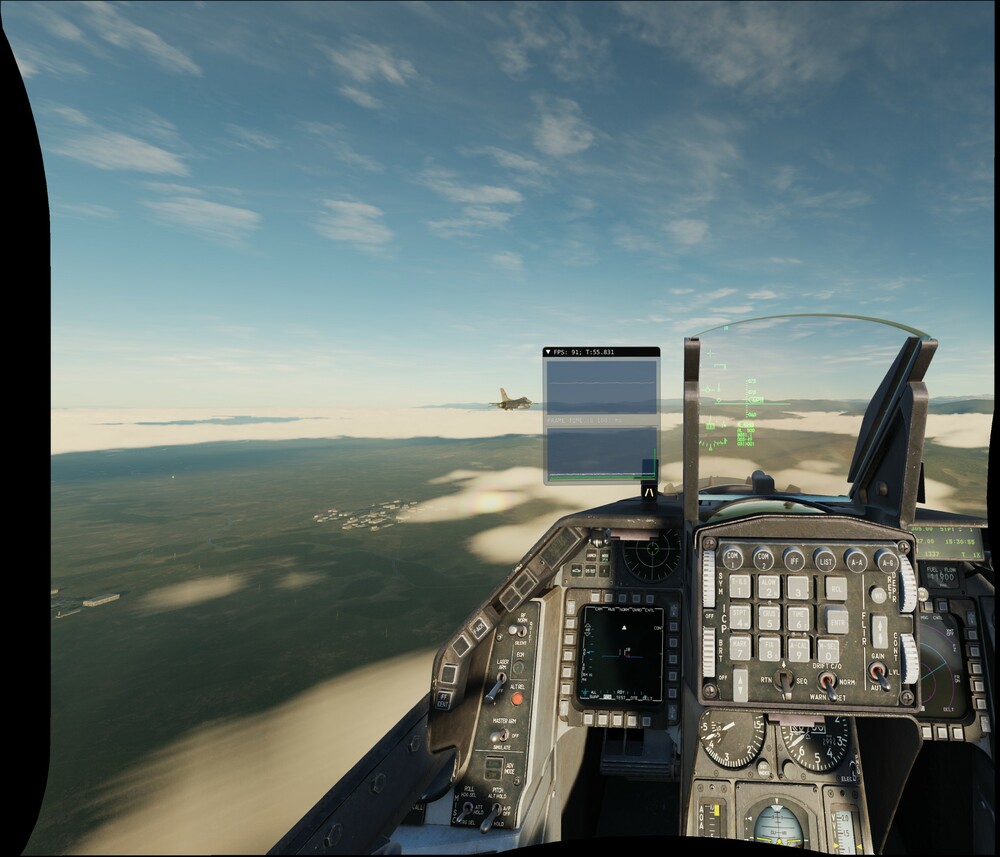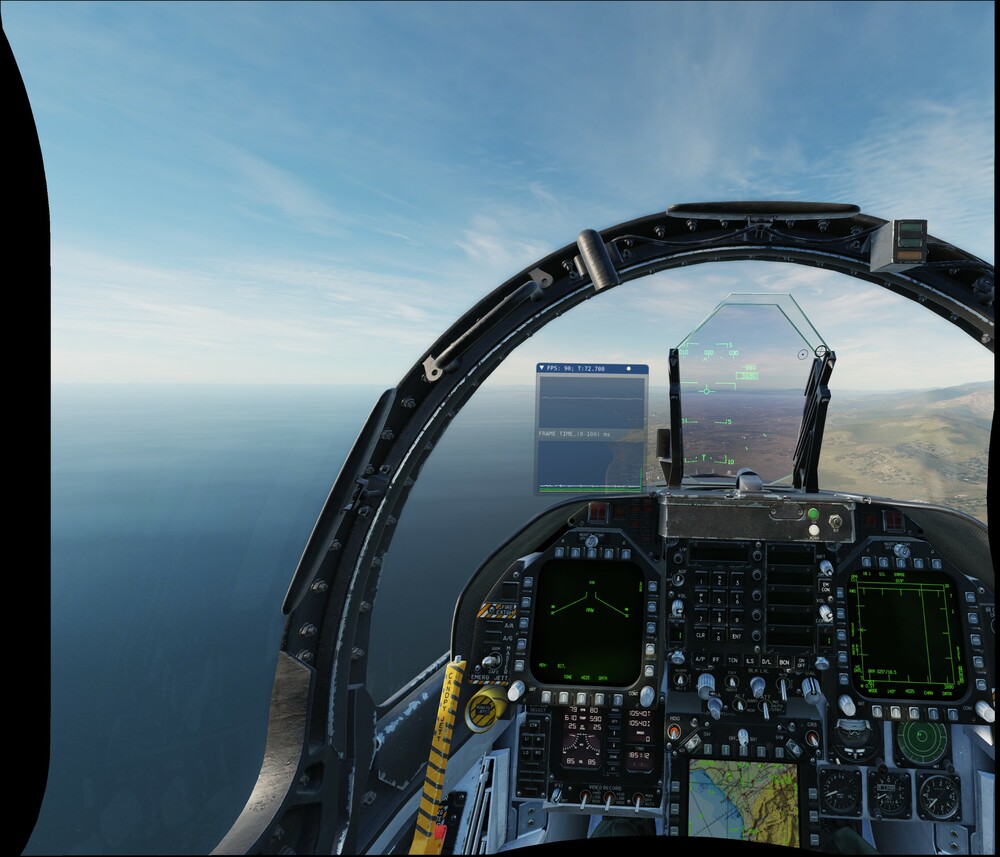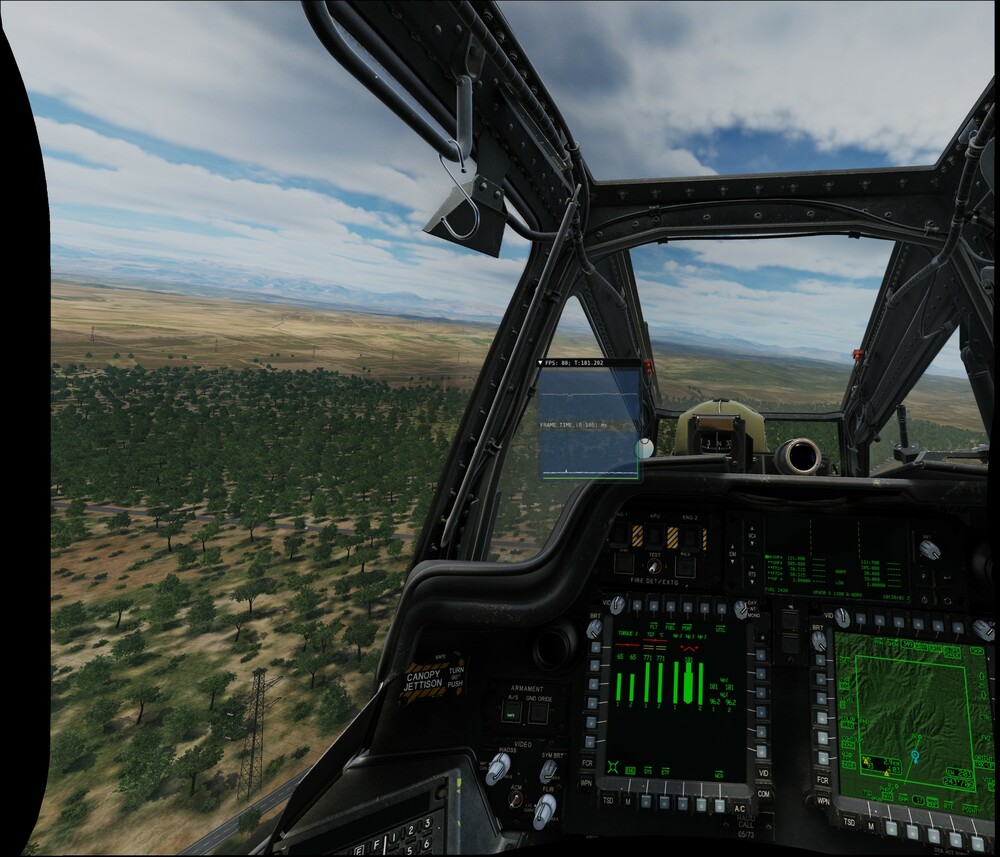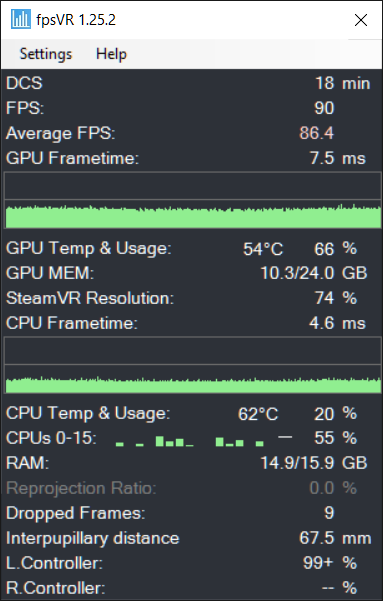

Supmua
Members-
Posts
2471 -
Joined
-
Last visited
Content Type
Profiles
Forums
Events
Everything posted by Supmua
-
nullIt's still possible to get good framerate, just need to do some finetuning. This is Apache Syria Hot Start Instant Mission on the Varjo at 3136x2688 pixels per screen, OpenXR, VR preset with MSAAx2, High textures/terrain textures, Flat shadows/terrain shadows (still bugged with soft shadow edges despite flat setting), Anisotropic filtering 4x. The 4090 and 5800X3D seem like a good combo. Don't expect this kind of fps on crowded MP server though, as the CPU will bog you down.
-
Fixed foveated works well and improves GPU frametime, dynamic foveation not so well and benefits might be offset by increased workload from eye tracking. In the other flightsim you get bigger performance boost from using DLSS (I’m talking nearly 20 fps in VR).
-
Just did some test flights with the newest version of OXRTK and Opencomposite OpenXR, and you know what it now gives better performance than SteamVR. OXRTK now reports accurate CPU frametime, and the new Turbo mode is nifty (this messes up traditional CPU FT measurement as the next frame is forced to render as fast as possible). With this I can run my Aero at 3360x2880 pixel per screen with my current DCS settings, and still gets smooth 90 fps in Harrier Free Flight Caucasus which is currently not possible with SteamVR with the current DCS beta (2.8) unless I lower the resolution.
-
Did you lock the frame to 45 via VB analytic window? If you did that already, this means the stuttering occurred during fps <45, and some settings need to be reduced to accommodate (resolution, shadows, visibility, textures, anisotropic filtering, etc. just do one at a time). This is why most people said the 2.8beta affected the performance with their setups. There’s still bugged flat shadows though and who knows what else, so expect things to get better with more patches.
-
There’s a new hotfix version 526.61 from NVIDIA that’s supposed to fix stuttering in some games. I didn’t notice any changes with DCS.
-
Meta’s tech is cool but that screen resolution is a big no in my book from a PCVR enthusiast’s point of view. What happened to the experimental headset that they showed off a few months ago with near retinal resolution?
-
The interchangeable lens to get different FOV and PPD is interesting. Wifi 6E is also a good move as it provides a lot of bandwidth. Since it will be using DSC compression like the Aero I wonder if it will support AMD GPU. According to a Varjo rep, NVIDIA pretty much owns the VR market right now so they’re not developing a driver for AMD GPU for their headsets. I’m not sure the Crystal will be ready to ship by Jan though. Forget about the 12K, my guess is late Spring or Summer. If they’re smart they’ll want to use the Crystal to test the water for now since it shares a lot of tech with the other one and I’m not even sure that the rtx 4090 will provide enough juice to drive the 12K.
-
They cut the price to $1599 which is a good move. No specific launch date though.
-
Been messing around with the settings, and it seems 3368x2888 pixels might be the optimal resolution for image quality vs performance on the Varjo. At this res shimmering is mostly gone (Persian Gulf free flights) and the clarity with Reshade luma sharpen applied is awesome pretty much as good as my flatscreen monitor. I can also further adjust tonemap exposure and gamma settings via Reshade for perfect detail retrieval in very bright and dark areas (optimized dynamic range if you will). With the new weather and lightings from the latest beta the end result is quite stunning. I also found that running at Highest Varjo setting (39 PPD or whatever that’s called) and downsampling to above res via SteamVR yields slightly better clarity. Chromatic aberration (color fringe) is also reduced at this Highest setting, but is also dependent on the angle of the VR lens against your face which is adjustable by tilting the headset’s side dials.
-
Yes, I found OXRTK’s CPU FT to be off by 4-5ms in MSFS where you can run both fpsVR and OXRTK at the same time via Steam OpenXR, no way to do this with DCS. I just upgraded (the CPU) this weekend also, and I’ve been pretty much GPU bound in DCS >90% of the time since 2.8 beta. Haven’t tried MP server yet though, mostly trying to mess around optimizing the PC since I’m new to the AMD system. What would be really neat is for someone to add (unofficial) DLSS mod to DCS for significant GPU FT relief, if modders can do this to Skyrim/Fallout 4/Resident Evil they should be able to make it happen for DCS also.
-
Yes, upgrading to rtx 4090 allows me to get 90 fps in free flight missions--performance degraded a bit since 2.8 (using my own preset) but with standard VR preset I'm still good there just don't like the image quality. I never got 90 fps in anything DCS related so it is huge for me. This wasn't possible with the 3090 due to GPU frametime not strong enough. I can't describe how good things look at stutter-free 90 fps especially in the cockpit area, it makes me want to keep flying. I also tested OpenXR vs SteamVR on the Varjo with the 2.8 beta, got exact same GPU frametimes from both modes. CPU frametime report for OXRTK is borked (per the author himself) so not using that for comparison between different API modes, but it is still useful for relative comparison within OpenXR when you adjust various gfx settings.
-
So far I've seen objective evidences of performance drop from people posting detailed graphs of CPU and GPU frametimes, but not the other way around. The performance increase group seemed mostly subjective which doesn't tell me much. Personally my setup didn't take a big hit (around 2ms in both CPU and GPU frametimes) but I did have to reduce some settings to accommodate. It's also hard to imagine that the new weather engine with moving clouds, lightings, rain effects, etc. would result in performance increase and not the other way around. I'm guessing the performance might improve a bit once the shadows bug is fixed, but probably not by much.
-
You can still get good framerate with the Varjo Aero. PC: Ryzen 5800x3D, RTX 4090. Aero: Very High setting, SteamVR 74%SS, final res 3104x2660 pixels per screen. DCS settings: VR preset plus High textures, High visibility, Low shadow, MSSAx2, Ans filtering X4 Mission: F/A-18C PG free flight. Add around 1-1.5ms to both captured CPU and GPU frametimes at that instant as the numbers dropped when I switched to fpsVR window for snapshot, so the actual numbers are slightly higher. But you can see that 90 fps is possible in those light flying still. I flew for 18 min, and the avg fps as you can see below (and 9 dropped frames in 18 min is pretty good). At this fps there is zero cockpit tearing/stuttering which is very nice as the Aero still lacks motion smoothing. Pardon my 16GB RAM, lol, these are my old sticks as my good ones are not compatible with the Ryzen. More observation: F-16 is a little less forgiving so I didn't quite get 90 fps in PG free flight, but mid 80s still. Flying low in Dubai dropped the fps into 70s, however CPU frametime stayed green (<11ms) all the way. So apparently Ryzen 5800X3D is a very strong CPU for flightsim, and in these free flight missions at above settings my 4090 is actually the bottleneck. And this is even with not-so-great RAM, although I did overclock it to 3000Mhz CL15. I left my GPU at stock settings due to recent fiasco with the melted connector, can probably get better GPU frametime with overlocking the GPU.
-

AMD 5800X3D, the new King for flight simulators?
Supmua replied to maxsin72's topic in Virtual Reality
I did the upgrade (5800X3D) and gained around 3ms of CPU frametime from 9900K, haven't done a lot of testings tho. Learned a lot from cross upgrading with mobo/cpu swap from AMD to Intel. 1. You can just swap mobo/cpu, Windows will boot (still using Win 10). 2. Some RAMs are not compatible, it wouldn't POST with my current DDR4 RAM and had to use another batch of older RAMs which worked. 2. All associated drivers will need to be installed. My LAN/Wifi didn't work and I had to download drivers from another PC and copied them over before gaining internet access. 3. Some peripherals weren't recognized (WinWing gear, MFG rudder pedals). Had to manually delete them from device window, unplug, restart and replug for detection--simply unplug and replug didn't work. Update: Crazy fps uplift in MSFS. Egypt flight activity, 81-83 fps, previously high 50s wow this is much more than DCS.






